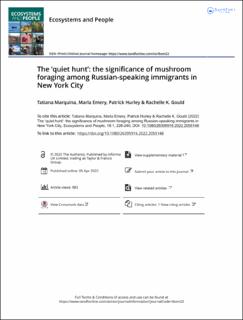The ‘quiet hunt’: the significance of mushroom foraging among Russian-speaking immigrants in New York City
Peer reviewed, Journal article
Published version

Åpne
Permanent lenke
https://hdl.handle.net/11250/3049331Utgivelsesdato
2022Metadata
Vis full innførselSamlinger
- Publikasjoner fra CRIStin - NINA [2364]
- Scientific publications [1392]
Sammendrag
Urban foraging provides city dwellers with numerous ecosystem services, but this human- nature interaction is largely missing from the urban ecosystem services scholarship. This exploratory study aims to address this gap in the literature and examines the benefits and values associated with foraging in New York City, United States. We focus on Russian- speaking mushroom foragers, a previously unstudied community. Data from 10 interviews reveals that for some groups, foraging is primarily about cultural ecosystem services, with a provisioning attribute. Foraging supports multiple benefits, most notably contributions to social relations, cultural heritage, and recreational experiences; these nonmaterial contribu-tions often intertwine with material benefits. Our findings further demonstrate the mutual exchange of benefits between humans and nature, including services to ecosystems and species. Participants reported engagement in multiple stewardship practices and actively maintained and enhanced ecosystem services. We encourage future ecosystem services assessments to recognize foraging as an urban activity and consider the bi-directional exchange of benefits between humans and ecosystems. To some participants, foraging was an integral part of their relationship with the natural world, intertwined with relational values of connection to nature, kinship, love, and care. Our results suggest that relational values can be central for understanding the value of ecosystem services. Our study further illustrates that some ecosystem services may be associated with practices, rather than places, and future work should examine these links in more detail. Environmental stewardship; human-nature connectedness; relational values; urban greenspaces; well-being
